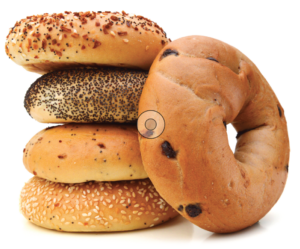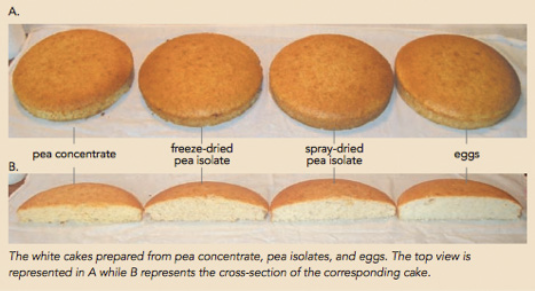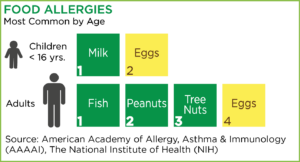Plant-Based Ingredients for Baking Applications
Pea protein as an egg-replacer and more
Introducing Our Solutions
 From high protein cookies to allergen-free brownies and vegan cakes, plus golden brown gluten-free bread, Axiom Foods has multiple ingredient solutions to help your formulating needs. These include dairy alternatives powders OryzOlait™ (from whole grain rice) and Avenolait® (from whole grain oats), Oryza™ rice syrup solid, Vegostar™ pea starch and multiple plant proteins from Oryzatein® rice to Vegotein™ pea.
From high protein cookies to allergen-free brownies and vegan cakes, plus golden brown gluten-free bread, Axiom Foods has multiple ingredient solutions to help your formulating needs. These include dairy alternatives powders OryzOlait™ (from whole grain rice) and Avenolait® (from whole grain oats), Oryza™ rice syrup solid, Vegostar™ pea starch and multiple plant proteins from Oryzatein® rice to Vegotein™ pea.

Oryzatein® Rises to the Fortified Bread Challenge!
 Looking for a way to improve the appearance of your gluten free bread or make a “good source of protein” or “lower carb” claim on a bakery application? Based on recent application testing, Oryzatein® 80 brown rice protein is your solution. The following test shows that Axiom’s rice protein can be beneficial for Maillard browning of gluten free breads, plus wheat replacement for lower carb and protein fortified breads—and all while not affecting the flavor nor the dough hydration.
Looking for a way to improve the appearance of your gluten free bread or make a “good source of protein” or “lower carb” claim on a bakery application? Based on recent application testing, Oryzatein® 80 brown rice protein is your solution. The following test shows that Axiom’s rice protein can be beneficial for Maillard browning of gluten free breads, plus wheat replacement for lower carb and protein fortified breads—and all while not affecting the flavor nor the dough hydration.
Testing showed that the addition of 33 grams protein per loaf is the sweet spot, increasing the protein per serving by 75%—from 2 to 3.5 grams protein per slice and reducing the wheat flour required for dough development and loaf volume. There is additional room for increasing the protein percentage but the addition of the rice protein altered the bread color from white to brown.
The addition of the rice protein did not change the mixing parameters or machinability of the bread dough. There was no adverse flavor noted. The rice protein could be successfully added at 1.5 grams and 3 grams per one ounce slice increase over the control of 2 grams protein for commercial bread (totaling 3.5 grams protein/slice and 5 grams protein/slice).
Effect of Oryzatein Rice Protein Addition to Wheat Flour White Bread
Purpose
To evaluate the effect that the addition of rice protein (for protein fortification) will have on the yeast bread loaf quality of white wheat flour bread.
Materials and Methods
1) Formula
Wheat bread formula [AACC Method10-09] “Basic straight dough bread baking method” modified to include oil. Currently, wheat flour bread provides 2 grams of protein per 1 ounce slice.
• Bakers™ Wheat flour — 100%
• Salt — 2.25
• Yeast, IDY — 1.11
• Water — 66
• Malt — 0.5
• Oil — 3
• Sugar — 7
2) Ingredients
• Wheat flour with 11.5% protein
• IDY yeast
• Malt from LaSaffre
• Rice protein [Oryzatein® 80] with protein of 83.4%
3) Equipment
• Kitchen Aid Mixer K5SS with J-hook
• Scale
• 1 pound [9 x 4.5 inch] commercial glazed bread pans from Chicago Metallica
• Oven
• Volume by displacement
4) Process
• Mix until development.
• Fermentation 2.5 hours
@ room temperature.
• Mould into shape
• Proof in pan 1 hour @ 80°F.
• Bake at 400°F for 30 minutes to internal temperature of 203 to 205°F
• Cool
5) Attributes measured and/or observed
• Dough mixing
• Dough quality
• Dough weight
• Final interior loaf temperature
• Record loaf weight, density, volume, grain, and loaf symmetry
• Photograph
Test Design
1. The control bread loaf had a calculated protein of
34.5 grams [2.156 grams per slice].
2. Add rice protein at increments of 33 grams to
bread formula.
3. Reduce wheat flour equal to the addition of the
rice protein.
4. The three test formulas of rice protein and quantity of protein per slice:
| Control (grams) |
Test 1 (grams) |
Test 2 (grams) |
Test 3 (grams) |
|
|---|---|---|---|---|
| Wheat Flour | 300 | 267 | 234 | 201 |
| Rice Protein | 0 | 33 | 66 | 99 |
| Total Protein | 34.5 | 30.7+27.5 =58.2 |
26.9+55.0 =81.9 |
23.1+82.6 =105.7 |
| Protein Per Slice | 2.156 | 3.64 | 5.1 | 6.6 |
Discussion and Results
1. The three doughs [control, test 1 and test 2] mixed well to development. However, as the rice protein increased the development of a window pane decreased and in test 3 there was no development.
2. The rice protein in test 1 and 2 did not affect the dough hydration. The rice protein did not have a competitive effect for water as some other ingredients [like bran] might.
3. The three doughs [control, test 1 and test 2] fermented well and molded very nicely. While test 3 failed to ferment sufficiently and test stopped.
4. During pan proofing the more rice protein replacing the wheat flour resulted in less dough volume corresponding to a smaller loaf volume.
5. Loaf data for the three rice protein breads:
| Control | Test 1 | Test 2 | Test 3 | |
|---|---|---|---|---|
| Bake yield [%] | 89.8 | 89.9 | 91.5 | failed |
| Loaf volume [cc] | 1848 | 1500 | 1213 | failed |
| Density [g/cc] | 0.257 | 0.318 | 0.398 | failed |
| Symmetry | good | good | good | failed |
![]()
6. Photograph of the bread loaves (left–control; middle–33 grams rice protein; right–66 grams of rice protein;grid of photoboard is 1⁄2 inch)
7. Photograph of the bread loaf ends and interior slices (left–control; middle–33 g brown rice protein; right–66 grams of rice protein):

Cakes made with pea protein scored a 10 for moistness compared with an 8 for cakes made with eggs, with testers concluding that cakes made with eggs had a slighter dry texture compared with cakes made with pea protein. Texture analysis on the chocolate cakes found that those made with pea protein had softer texture (lower peak load values) than the egg cakes after one day of storage, but slightly higher peak loads than egg cakes after two days of storage. Functionally, freeze-dried pea isolate performed similar to spray-dried isolate (part of the Vegotein process).

The Cookie Trial
Pea protein proved to be a viable alternative for eggs in both sugar snaps and chocolate chip cookies. Based on these results, food manufacturers can expect cookies made with pea protein to look like cookies made with eggs, with similar cookie spread and height. Pea protein cookies had greater moistness than cookies made with eggs. Objective measurements on cookies made with pea isolates confirmed lower peak hardness and thus softer textures than cookies made with eggs. Indeed, texture analysis indicates that pea protein has a tenderizing effect. Peak hardness values for cookies made with isolates are 1.89 times harder than the cookies made with eggs.
Despite uniform baking times, chocolate chip cookies made with fresh eggs were darker in color than those made with pea protein isolates (≥80%*), suggesting that Maillard browning was an issue. The sugar snap cookies used dehydrated eggs in the control and were similar in color across all comparisons.
Stability—In Triplicate
#1 Emulsion stability: Pea protein holds on to both fat and water, making a creamy, stable emulsion that offers process stability, holds flavor components together and improves shelf life.
#2 Process stability: A powder that blends conveniently into dry ingredients, liquids and batters. Pea protein won’t lose its structure or functionality under high temperatures, pH fluctuations or pressure. Such stability enables high-stress processes such as baking, deep frying and extrusion.
#3 Extrusion stability: Pea protein can replace gluten as a stabilizer in snacks and cereals, becoming part of a matrix that allows expansion; thereby maintaining desired structure, texture and shape.
Practical, Affordable, Functional
Because peas are a legume plant that naturally makes and returns nitrogen fertilizer back into the soil, they are as healthy to grow as they are to eat.
Pea protein maintains volume without expansion in bread crumbs and brownies. It stretches gluten supplies in conventional baked goods because pea protein mimics the bulk and structure of wheat flour. And now, reduces market exposure to fluctuating egg costs by using pea protein as an egg replacement in baked goods and pastas.
The Isolated Facts
As little as 2% to 5% of a pea protein isolate (≥80%*) added to wheat flour is enough to hike the nutritional value without major formula changes. Highly refined to reduce oligosaccharides, pea protein isolates (≥80%*) offer improved flavor, mouth feel and digestive ease, in addition to providing a higher protein claim with fewer grams. These attributes allow increased protein levels in foods such as high-fiber, high-protein, low-calorie breads without changing their flavor. Don’t fret about cardboard chewiness. Pea proteins provide their potent protein boost without that mouth-drying woody taste.
A “Niche” Market of 30 Million?
Egg allergy isn’t the temporary problem once assumed. Results from a recent and large John Hopkins study found 32% of those diagnosed as kids continue to suffer reactions to egg after the age of 16, many of them throughout adulthood. Adult allergies are a little less prevalent than kids.

Beyond allergies, sensitivities to egg and egg-containing products explodes the market for a functional egg replacer to more than 30 million people, according to CDC’s conservative estimates. Indeed, many people who can’t tolerate egg products don’t have an actual egg allergy as medically defined, but rather a sensitivity to eggs, including inflammation and diarrhea. In England, some 53% of those recently surveyed had intolerance to egg white and 32% to egg yolk. That’s a lot of folks looking for an egg-free eating experience.






